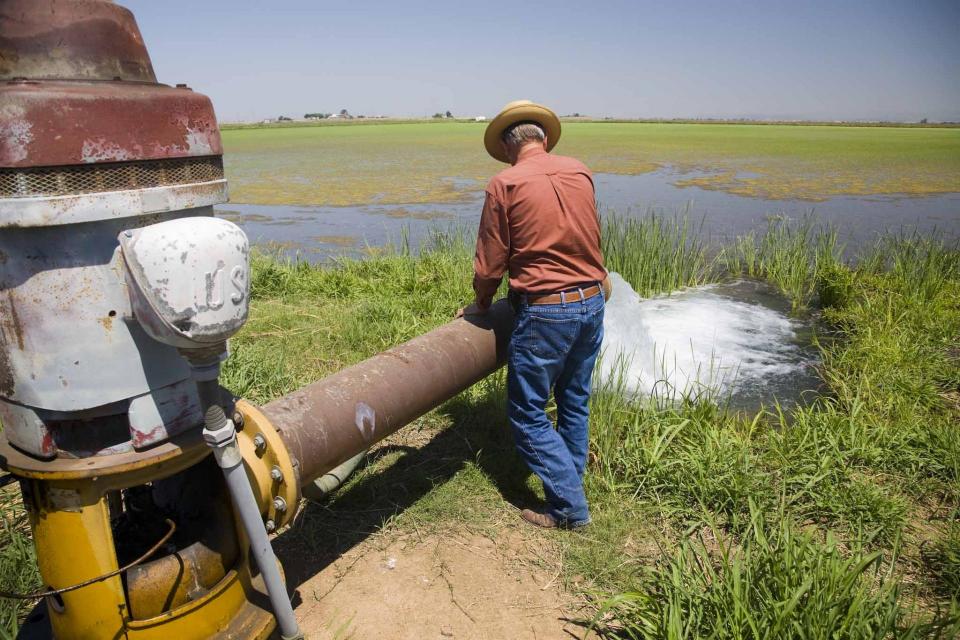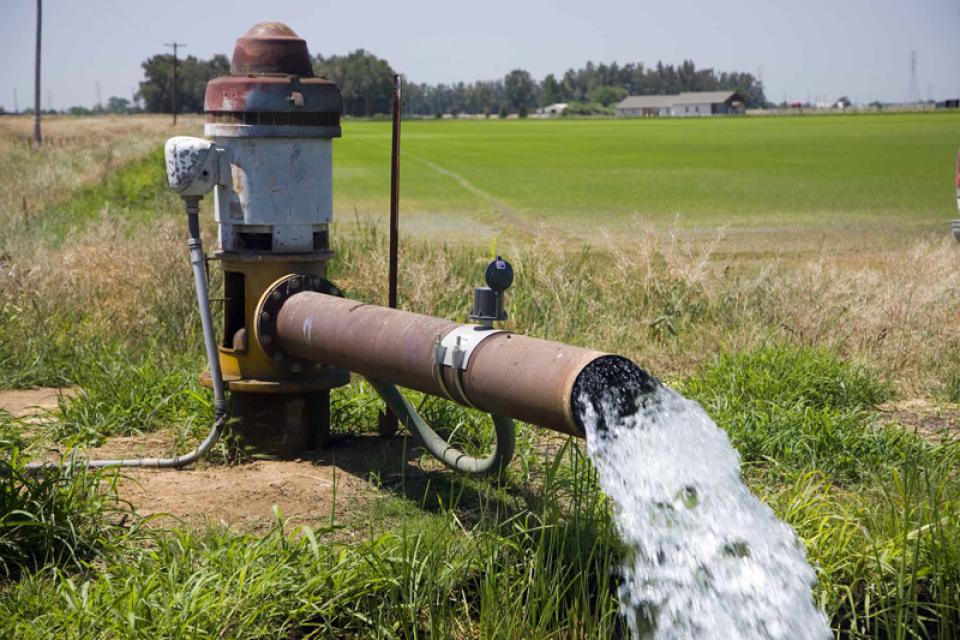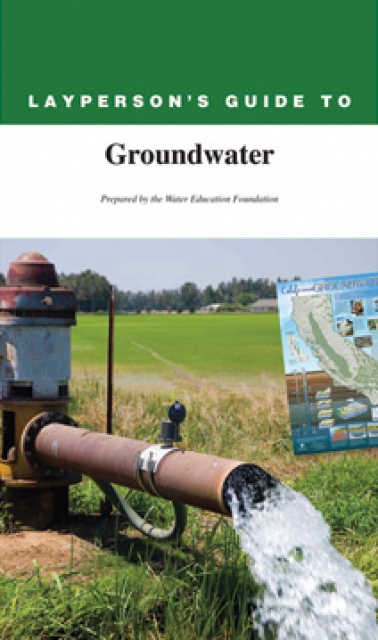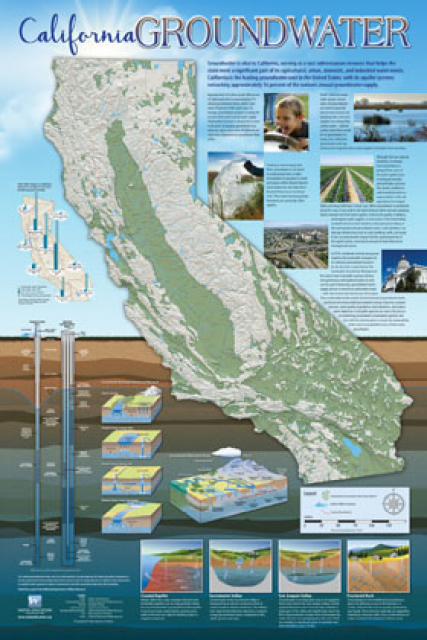Sustainable Groundwater Management Act (SGMA)
 A new era of groundwater management
began in 2014 with the passage of the Sustainable Groundwater
Management Act (SGMA), which aims for local and regional agencies
to develop and implement sustainable groundwater management
plans with the state as the backstop.
A new era of groundwater management
began in 2014 with the passage of the Sustainable Groundwater
Management Act (SGMA), which aims for local and regional agencies
to develop and implement sustainable groundwater management
plans with the state as the backstop.
SGMA defines “sustainable groundwater management” as the “management and use of groundwater in a manner that can be maintained during the planning and implementation horizon without causing undesirable results.”
When fully implemented, SGMA is expected to effectively administer groundwater pumping, though it remains to be seen if some of the damage done to aquifers is irreparable. Without SGMA, however, there is no hope for management.
In California, groundwater is a critical source of water for both farms and cities, supplying 40 percent of water in a typical year and as much as 60 percent in drought years.
Under SGMA, high- and medium-priority basins as designated by the California Department of Water Resources (DWR) must establish Groundwater Sustainability Agencies (GSAs). The GSAs, made up of one or more local agencies overlying a groundwater basin, are required to develop Groundwater Sustainability Plans (GSPs). GSAs responsible for high- and medium-priority basins must adopt their sustainability plans by Jan. 31, 2020 or Jan. 31, 2022, depending on whether the basin is in critical overdraft. Agencies may adopt a single plan covering an entire basin or combine a number of plans created by multiple agencies.
Almost 300 Groundwater Sustainability Agencies have formed around California to begin the process of bringing overdrafted basins into balance. SGMA gives those agencies numerous new tools and authorities to manage the groundwater and implement the objectives of their sustainability plans. These include the authority to conduct investigations, determine the sustainable yield of a groundwater basin, measure and limit extraction and impose fees for groundwater management.
In 2017 DWR announced that more than 99 percent of the high- and medium-priority groundwater basins are covered by a GSA, adjudication or alternative sustainability plan.
Implementing SGMA
GSPs, which have a 20-year implementation schedule and a 50-year planning horizon, must include a physical description of the basin, including groundwater levels, groundwater quality, subsidence, information on groundwater-surface water interaction, data on historical and projected water demands and supplies, monitoring and management provisions and a description of how the plan will affect other plans, including city and county general plans. GSPs can build upon existing groundwater plans.
Where multiple GSPs within a basin are developed, a single, coordinated GSP must be submitted to DWR. The idea behind a single document is to “synthesize and connect” the technical and management elements from each GSP “so that there is a consistent and orchestrated plan to sustainably manage the groundwater for the entire basin,” according to DWR. There are several funding needs, beginning with the creation of GSPs themselves, followed by inspections and enforcement, project construction and the necessary daily operations and maintenance. That money may be drawn from different sources, such as taxes, assessments, property-related fees and regulatory fees.
Basins in overdraft must achieve groundwater sustainability by 2040 or 2042, predicated on the completion of plans. If deadlines aren’t met, the State Water Resources Control Board (State Water Board) can intervene and establish an interim management plan.
SGMA stipulates that it is not a “one size fits all” approach and that each groundwater basin is different. It does not remove the distinction between surface water rights and the personal, private property right to pump groundwater and does not allow the disclosure of how much water an individual takes. The state can intervene only in extreme conditions when local control is inadequate.
SGMA’s schedule recognizes that it took decades, if not more than a century, to get in the present predicament and that it will take a reasonable amount of time to get troubled areas on the right track. If the aim was to reach sustainability in three to five years, some areas would have to essentially stop pumping, causing a significant economic impact throughout the entire agriculture sector through reduced sales and property taxes.
The San Joaquin Valley’s annual groundwater deficit has averaged about 2 million acre-feet and only about a quarter of that deficit can be filled with new supplies at prices farmers can afford, according to the Public Policy Institute of California. Ending overdraft could require taking at least 500,000 acres of irrigated cropland out of production. Groundwater recharge projects are vital to resuscitating depleted basins, but there are obstacles to moving floodwaters to recharge basins.
Enactment of SGMA has prompted questions of what the endgame is for groundwater in California. It is clear that unbridled pumping cannot continue and that the first choice is for local people to decide how to manage groundwater. With that in mind, some sort of water budget will have to be implemented to alleviate existing overdraft and allow aquifers to recover, where possible. Ultimately, that means less pumping and less water.
Despite its ambitious premise, SGMA’s effectiveness remains to be seen. Well-drilling has continued in some overdrafted areas, and nearly 60 percent of the initial GSPs, particularly in the San Joaquin Valley, were deemed deficient or incomplete by DWR. To the extent that so many plans require revisions to win state approval, it’s clear that SGMA will not be static, but instead is a work in progress.











